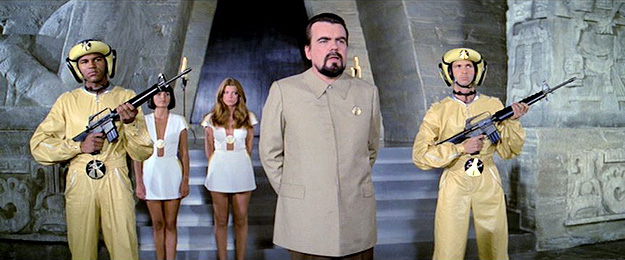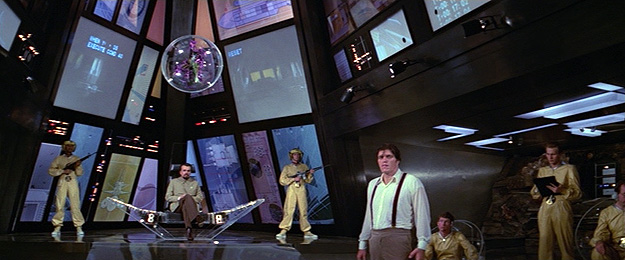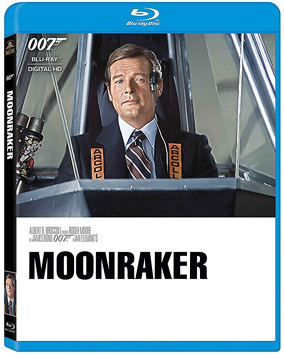Coate: In what way was Michael Lonsdale’s Hugo Drax a memorable villain?
Altman: At the time, I thought Michael Lonsdale’s Hugo Drax was a second-rate Bond villain, but I’ve come to appreciate him a lot more over time. His droll sense of humor (“Find Mr. Bond. See that some harm comes to him.”) is really quite delightful and different than a lot of the other Bond baddies. One of my favorite scenes in all the Bond movies is when they go quail hunting and after Bond misses his shot, nailing a would-be assassin in the trees, he disparages Bond by saying, “You missed, Mr. Bond” to which Roger Moore playfully replies, “Did I?” as the assassin drops from a nearby branch. It’s just so pitch perfect as is the stunning scene that immediately follows in which Drax dismisses the beautiful Corinne Dufour and dispatches his Dobermans to devour her. She runs through the forest chased by the hungry dogs to the strains of John Barry’s brilliant score and I think it’s just marvelous. Ultimately, I think Drax is somewhat diminished by the fact that he basically has the exact same motivation as Karl Stromberg in the previous film, and it doesn’t help that Moonraker is pretty much a remake of Spy Who Loved Me... in space. Although I do love when M and the Minister show up with Bond and are greeted by Drax who inveighs that he doesn’t get the British sense of humor. I’ve subsequently grown to love Lonsdale in so many films, perhaps never better than in John Frankenheimer’s Ronin, so my estimation of him has grown considerably since the first of many viewings which now probably numbers in the hundreds.
Cork: Lonsdale’s Drax wins the prize for the most insouciant Bond villain. He plays the entire film as if he had just been briefly woken from hibernation. When I watch the film, I find myself wondering about halfway through his somnambulant “here in the untainted cradle of the heavens” speech, who let this guy out of the opium den? Lonsdale can be a fantastic actor, bringing real menace to a role, but he looks like someone embarrassed to be there hoping that if he just speaks in enough of a monotone and doesn’t move, no one will notice him. You get a small taste of the villain he might have been during the final confrontation with 007 where a bit of the manic obsessive comes through. Yet, even there, the lingering delay in dispatching Bond allows Roger Moore enough time to smirk, slowly raise his hands, toss off a bon mot (and probably boil water) before shooting Drax with wrist dart gun. Had that gadget been used in the innumerable other scenes between 007 and Hugo, it would have saved us all a lot of trouble. My super-cut of the film would have Drax uttering the line, “James Bond. You appear with the tedious inevitability of an unloved...” and Bond would shoot him right at that moment with his wrist dart gun, leaving mankind to wonder what Drax would say to finish his half-baked idea. An unloved Village People song? An unloved creepy uncle? An unloved egg salad sandwich?
One of the ways one can tell what was lacking in this translation of Drax from Fleming’s novel is the repeated attempts to put a character closer to the literary Drax into a Bond film. Trevelyan in GoldenEye was based on Fleming’s Sir Hugo Drax, as was Gustav Graves in Die Another Day. That’s how robust Fleming’s Drax is, and how much was missing from the character in Moonraker.
Pfeiffer: Despite my criticisms of Moonraker, I look more favorably on its good elements today. Among them is the performance of Michael Lonsdale, who is generally dismissed as being bland and understated. In fact, I find his performance to be very amusing. He’s given some of the film’s wittiest lines and makes the most of them. I wouldn’t call him one of the most memorable Bond villains but he deserves more praise than he’s received.
Coate: In what way was Lois Chiles’ Holly Goodhead a memorable Bond Girl?
Altman: Lois Chiles isn’t a great Bond girl, but as a CIA agent-cum-astronaut, she is a resourceful one, and like Major Amasova before her is a big step up from the dreadfully vacuous and shrill Miss Goodnight in The Man with the Golden Gun. Chiles isn’t a great actress, but she’s incredibly sexy, although the name is trying too hard to be provocative when it’s just dopey. That said, she also has a wonderful way of cutting down Roger Moore’s double entendrés and sexist banter (“A woman?”) and, frankly, no one could credibly pull off the line, “Take me around the world one more time, James.” When I saw the brilliant James Brooks movie Broadcast News a few years later, I always wondered why Holly Goodhead left NASA, the space agency, for a life as a journalist.
Cork: Lois Chiles was one of the most beautiful women on the planet when Moonraker was made. The last shot of her looking up at Bond, sly grin, twinkling eyes, her perfect delivery of probably the best double entendré of 1979, perfectly establishes what is memorable about her. But from the first, I always sensed this underlying unease in Chiles as she played Holly and a sense of sadness and loneliness in her eyes. I think there are a lot of reasons for that. First, her character seems less than driven in her mission, doing things like strapping Bond into a centrifuge and then wandering off, sleeping with him in Venice after he sneaks into her hotel suit, then acting like he’s the last person she would want to see in Rio. It is a very ragged, uneven character on the page. Second, Lois has talked publicly about how little direction she was given, and on a big film like Moonraker, where the actors can’t be expected to see the full picture, that connection with a director is important. Third, the most importantly, Lois had a brother with whom she was very close who was ill with Hodgkin’s disease and getting worse during filming. Lois was a match for him to donate blood platelets, so a lot of her emotional energy was naturally focused on her family, and her desire to get back home so she could donate blood to help keep her brother alive. He died before Moonraker opened. After Lois shared that story with me, I watch her performance in light of the very real drama she was going through at the time. I think she did a fantastic job, particularly under the circumstances.
Pfeiffer: The character of Holly is somewhat underwritten. There isn’t too much for Lois Chiles to work with other than to look beautiful. In retrospect, though, the film was ahead of its time in presenting her as female action hero in an era in which that was a rarity. The character refutes the old criticism that Bond women were pretty but dumb. Holly graduated Vassar and excelled at NASA, which makes for a good one-liner later in the film. She’s both brave and brainy and Lois Chiles never slips into the helpless woman scenario, screaming “JAAAaaammmess” as was the case in some of the other films.
 Coate: Where do you think Moonraker ranks among the James Bond movie series?
Coate: Where do you think Moonraker ranks among the James Bond movie series?
Altman: I rank this movie on a totally different scale than the others. Albert R. Broccoli set out to capitalize on the success of Star Wars and that’s exactly what he did. It’s a weird amalgamation of Bond and the late 70s zeitgeist and it’s very much a product of its time and not quite a Bond movie. It’s silly and absurd and as far away from the grounded espionage of From Russia with Love as you can imagine and yet I’d be lying if I didn’t have a soft spot in my heart for this film. In fact, I watch it quite a bit. It epitomizes all the excess and silliness of the Roger Moore years, but that’s not necessary a bad thing. The teaser is one of the greats with the parachute dive in which Bond is literally thrown out of an airplane without a parachute and yet it ends with Jaws flapping his wings and crashing into a circus tent completely illustrating the schizophrenia inherent in this film which goes from 100 to 0 in mere nano-seconds. But any Bond film with a top-notch John Barry score, magnificent Ken Adam production design and skillfully directed by Lewis Gilbert, can’t be all bad. There’s more style here than in any of the John Glen films that follow and there’s some real tension in the Rio sequences and a crackling boat chase as well. And if you’re willing to grant the film its excesses, the last 20 minutes on the space station as Bond and the American cavalry have a laser gun battle with Drax’s minions in outer space, it’s a super entertaining lark. Not to mention, I’ve always been amused that the climax to Moonraker and Star Trek: The Motion Picture, which opened a few months later, are virtually the same and you certainly could argue that Moonraker’s is a helluva lot more interesting.
Cork: This is tough. The film has so many fantastic moments: the free-fall opening, the centrifuge, the dogs unleashed on Corinne, the amazing shuttle launch simulations by Derek Meddings, the destruction of the globes as Bond and Holly are skipping across the atmosphere in their shuttle. But it has so many moments that crush the spirit of Bond fans: the gondola hovercraft, the horrendous effects of Bond and Holly sliding down cables in Brazil, and a general lassitude that permeates the film. Out of 26 Bond films, including the ’67 Casino Royale and Never Say Never Again, I place Moonraker in slot number twenty-one. It’s something to watch if you have a few hours to kill in Rio, and you don’t samba.
Pfeiffer: I rank it among the bottom tier of films but I’ve grown to appreciate the expensive look and scope of the film. The special effects were very good for the day. It doesn’t make the mistake that Golden Gun did, which is presenting a rather cheap look to the production even though it cost a lot of money. Moonraker has style and it also benefits from a very good theme song and score by John Barry. It also represented the last Bond film that Ken Adam designed the sets for and they are suitably grandiose and impressive. I also liked the scene where Bond is trapped in the centrifuge, a rarity in the film because it isn’t compromised by silly comedic efforts. The movie does contain my single favorite Roger Moore Bond moment. It occurs when he calmly shoots that would-be assassin out of a tree, then calmly hands Drax his shotgun and doesn’t bat an eye as Drax’s chauffeur drive him to the airport. It encapsulated the aspects of Moore’s Bond that defined his interpretation so uniquely. I’ve even grown fond of the idea of turning Richard Kiel’s Jaws into a hero at the end, but the romantic nonsense between his character and Dolly is still dreadful to endure. Moonraker had the makings of a very good film and with judicious editing of about five minutes of screen time, it still could be. Many years ago, I knew someone who did just that by creating his own “improved” version of the film that eliminated the over-the-top slapstick elements and the obvious product placements. It was a crude concoction in the pre-digital age, but I do recall it played very well indeed.
Coate: What is the legacy of Moonraker?
Altman: This is the Bond film that “real” Bond fans love to hate. But to me, whatever its faults, and there are many, it’s incredibly entertaining. I’d rather watch Moonraker a hundred times than suffer through The Man with the Golden Gun, Never Say Never Again, Licence to Kill or the last hour of Die Another Day again. Obviously it had a profound effect on the Bond film series in that despite its success, Cubby Broccoli was wise enough to realize that the series needed to go “back to basics” to endure, a philosophy that has kept it alive for decades subsequently whether with The Living Daylights, GoldenEye or Casino Royale. Unfortunately, the same bloat seems to happen again and again with these films and if I’m going to watch a big, bloated, silly James Bond film, there’s no better one than Moonraker (unless you put Thunderball and You Only Live Twice in this category, which I don’t). Plus back in the days when Bond films came out like clockwork every two years (as they should), there’s always the old Ed Wood adage and hope, “Maybe my next one will be better.”
Shameless Bond plug: Finally, if you’re a Bond fan, you might want to check out my new sci-fi TV series, Pandora, which debuts in July on the CW. It not only features Judi Dench’s nephew, Oliver Dench, who’s brilliant, but several Bond movie veterans as guest stars including Maryam d’Abo, so I hope you’ll tune in. If you watch carefully, you may even see or hear some Bond Easter Eggs.
Cork: The legacy of Moonraker is the rise of Michael G. Wilson. After the film came out, he went to his step-father, Cubby Broccoli, and said the scripts needed to be better. He had been the brainchild behind the two greatest stunt sequences in Bond history, and Cubby and UA knew it, so Michael was given the keys to the kingdom. He was put in charge of working with Richard Maibaum on the next script, and Maibaum soon decided that he and Wilson should be a writing team. Wilson was in on every key creative decision, and every business decision, too. Michael G. Wilson is a smart, collaborative, no B.S. man who has three great talents that he brought to 007: he has a background in engineering, a background in law, and a great instinct for visually exciting filmmaking.
Additionally, Moonraker was part of the last great era of United Artists. The studio had been founded on the idea that filmmakers, not bankers and businessmen, should make movies. When Cubby Broccoli and Harry Saltzman made their deal with UA, the agreement was simple: as long as a filmmaker could stay on budget, UA would finance and distribute the film, but it would not interfere. But when Transamerica Corp., a holding company that originally owned Bank of America, decided to go on a diversification buying spree, and purchased UA in 1967, many worried the unique business model would change. It did. UA was just another division, like their charter airline business and Budget Rent-A-Car. Eventually, things became so bad that the entire executive brain-trust of UA resigned and formed Orion Pictures in 1978. “I just do not think they understand the motion picture business,” said UA exec Arthur Krim about Transamerica upon leaving. Cubby Broccoli remained. He had to. Harry Saltzman had sold his half of the James Bond rights to UA when he left in 1975. Although the executives left in January 1978, the deals they made with Woody Allen, Broccoli, and Sylvester Stallone produced record box office for the company in 1979. Unfortunately, the next year was filled with films greenlit by the new team. This included the massively expensive Heaven’s Gate, prompting Transamerica to sell UA off, starting a long, painful spiral that continues to this day. One hopes that the glorious days of UA in the 1960s and 70s can come again, but Moonraker and the other great UA films of 1979 marked the glorious end of a great studio run by visionary executives.
Pfeiffer: If the film has a legacy, it isn’t a particularly favorable one except to say that mainstream audiences and critics tended to like it and it was a financial success. The movie was inspired to cash in on the success of Star Wars. In fact, For Your Eyes Only was bumped back to the next film in order to accommodate Moonraker. I understand the financial reasons for capitalizing on the outer space craze but it bothered me that Bond was now following another franchise instead of being the franchise that was being imitated.
Coate: Thank you — Mark, John, and Lee — for participating and sharing your thoughts about Moonraker on the occasion of its 40th anniversary.
The James Bond roundtable discussion will return in Remembering “Licence to Kill” on its 30th Anniversary.
IMAGES
Selected images copyright/courtesy 20th Century Fox Home Entertainment, CBS-Fox Home Video, Danjaq LLC, Eon Productions Limited, MGM Home Entertainment, United Artists Corporation.
- Michael Coate
Michael Coate can be reached via e-mail through this link. (You can also follow Michael on social media at these links: Twitter and Facebook)







